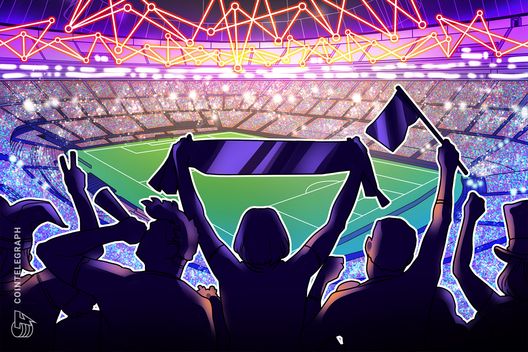
Opinion by: Dima Saksonov, founder and CEO of Atleta Network
The sports industry has become the distribution channel for blockchain’s mainstream moment. Leagues, teams and venues are running verifiable ticketing, identity and rights-management systems as mission-critical infrastructure that operates at stadium scale.
This shift has positioned sports organizations as decisive buyers that carry blockchain into everyday fan experiences.
In the earlier cycles, crypto chased shortcuts to make a name in the mainstream, and the sports industry (eagerly looking for a fresh revenue stream) has become the first to embrace this novel take on finance. Naming-rights deals put exchange logos on NBA arenas, as crypto sponsorships in sports reached a national level.
While this generated crypto brand awareness, the focus remained on visibility over embedding real, tangible value within the sports ecosystem itself. Since the last cycle, the follow-through has been an operational agenda that includes ticketing fraud prevention, verifiable player data, smarter fan engagement and transparent contracts.
Solving real problems on and off the field
Sports run on operational efficiency. This cycle, the supply side finally caught up: Blockchain teams are shipping production-ready ticketing, identity and settlement modules. The practical path is consolidation on a single, purpose-built network that clubs can standardize on across venues and partners. This allows leagues to finally integrate these systems into stadium operations, opening new revenue streams and deepening fan engagement through transparent and immutable technology.
Blockchain-based ticketing curbs fraud and enforces secondary-market rules; verifiable onchain data supports transparent athlete metrics for scouting and fantasy; and smart contracts automate multiparty agreements for sponsorships and endorsements. Analysts project that the blockchain market in the sports industry will have increased from approximately $2.05 billion in 2024 to $10 billion by 2035.
Closed, single-purpose products cannot meet league requirements. Leagues need a standardized settlement layer with one policy surface, one fee model and one observability stack. A single purpose-built sport-optimized network lets fans use one account in official team apps, while clubs plug in to the same compliant infrastructure for ticketing, loyalty and payouts.
The result is a unified loyalty identity anchored to a single network and recognized across participating leagues and clubs. Digital collectibles and perks live in one wallet and one marketplace rail, improving liquidity, data integrity, supportability and user trust.
The essential use cases — tickets, data trails, loyalty and rights management — are clear, but there remains a shortage of robust prototypes in the field. That gap highlights the need for production-grade modules that have been audited for privacy and compliance.
Governance and integrity workflows are moving, too. Blockchain architectures can enhance integrity utilized for doping control and credential verification, ensuring audits are tamper-evident and access-controlled across organizations. In practice, that means more transparent chains of custody for athlete data and faster verification for staff credentials at major events.
Related: Fan tokens offer stability — NFTs have not
Fans don’t need to learn new tooling. A secure mobile ticket that unlocks the turnstile, a digital collectible that redeems for a seat upgrade or a verifiable vote on a club initiative are familiar actions wrapped in better rails. Today, the wiring for the fan has disappeared. A blockchain-backed ticket can feel exactly like a normal one: You open an email, flash a QR code and walk through the turnstile.
You don’t need to know how QR codes work or that the email itself operates on a different protocol to use all three layers effortlessly. The chain hums in the background, while the experience stays familiar. The lasting lesson is that product-market fit lies in repeatable, embedded interactions.
The excitement of sports reaches fans across all ages and geographies, extending beyond typical crypto user profiles. When secure mobile tickets, verifiable collectibles and loyalty mechanics live inside official team apps, the chain functions as an invisible rail that meets people where they already are. Stadium routines, including entry scans, seat upgrades and postgame rewards, become repeat onchain interactions that build familiarity week after week.
Where the value accrues
Budgets have begun to migrate from splashy sponsorships to multi-year software and settlement contracts that touch every matchday like ticket issuance, access control, loyalty accrual and rights accounting.
Vendors that demonstrate measurable drops in ticket fraud, predictable secondary-market royalties and faster payout logic for performance incentives will win league-wide agreements. Procurement will favor a single network that integrates with existing fan databases and stadium turnstiles, hides wallet complexity inside official apps and provides auditable data to regulators on demand.
This reframes how to judge “winning” chains. Venue-scale throughput in tight windows matters; think hundreds of thousands of scans around kickoff, as do privacy guarantees that pass data-protection audits. A common settlement layer reduces risk while simplifying vendor management.
The stack must be modular on a single chain: pluggable data availability, configurable permissions and standards for verifiable credentials recognized across the network without fragmenting the fan journey. Ultimately, the winning solutions will deliver on three core promises: transparency, automation and verifiable settlement.
Sports are no longer just a marketing vehicle for crypto; they are a proving ground where blockchain becomes indispensable infrastructure. Fans are already interacting with the technology when they buy a ticket, vote on a team decision or trade a verified digital collectible, often without even realizing it.
The next phase of adoption is driven by practical wins that make venues safer, settlements cleaner and fan journeys smoother — the kind of incremental gains that compound across seasons.
One chain that earns its place in stadium infrastructure earns a path into mainstream consumer life.
Opinion by: Dima Saksonov, founder and CEO of Atleta Network.
This article is for general information purposes and is not intended to be and should not be taken as legal or investment advice. The views, thoughts, and opinions expressed here are the author’s alone and do not necessarily reflect or represent the views and opinions of Cointelegraph.
